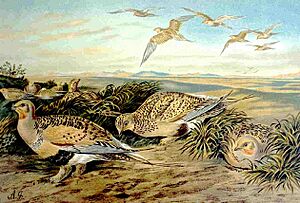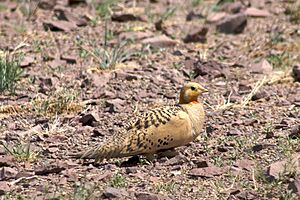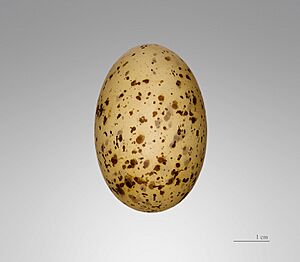Pallas's sandgrouse facts for kids
Quick facts for kids Pallas's sandgrouse |
|
|---|---|
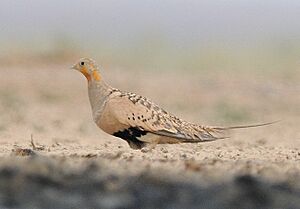 |
|
| Conservation status | |
| Scientific classification | |
| Genus: |
Syrrhaptes
|
| Species: |
paradoxus
|
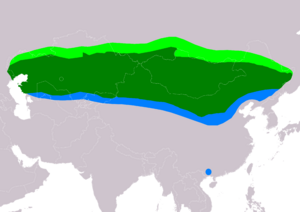 |
|
| Range of S. paradoxus (Compiled by: BirdLife International and Handbook of the Birds of the World (2016) 2016.) Breeding Resident Non-breeding | |
The Pallas's sandgrouse (scientific name: Syrrhaptes paradoxus) is a fascinating bird. It's a medium to large-sized bird that belongs to the sandgrouse family. These birds are known for living in dry, open areas.
Contents
What's in a Name?
This bird gets its name from Peter Simon Pallas. He was a German zoologist who studied animals. He first described this bird in 1773.
The scientific name, Syrrhaptes paradoxus, comes from Ancient Greek. Syrrhaptes means "sewn together." This refers to their unique toes, which are fused. Paradoxus means "strange," highlighting its unusual features.
Long ago, around the year 1300, the famous traveler Marco Polo wrote about a bird. He called it Bargherlac. This bird was likely the Pallas's sandgrouse.
Appearance and Features
Pallas's sandgrouse is about 30 to 41 centimeters (12 to 16 inches) long. It has a small head and neck, similar to a pigeon. However, its body is strong and compact.
It has long, pointed wings and a pointed tail. Its legs and toes are covered in feathers. The bird's body is mostly a sandy, buff color. It has black stripes on its back and a black patch on its belly. Its underwings are pale.
You can tell the male Pallas's sandgrouse apart by its gray head and chest. It also has an orange face and a gray band across its chest. Females look a bit duller. They don't have the chest band, but they have more stripes on their upper body.
Special Feet
The feet of the Pallas's sandgrouse are very unique. They don't have a back toe. The three front toes are fused, or "sewn together." The top of their feet is feathered, and the bottom has a soft, fleshy pad. This makes their feet look more like paws than typical bird feet.
Where They Live and Travel
These birds live and breed across the dry steppes of central Asia. Steppes are large, flat grasslands. They make their nests on the ground. A nest is usually a simple scrape where they lay 2 to 3 greenish eggs. The eggs have patterns that help them blend in.
Pallas's sandgrouse are partial migrants. This means some of them travel south for winter. Birds from the northern parts of their range, like Kazakhstan and Mongolia, often migrate. How far they travel depends on how much snow falls.
Sometimes, these birds travel far outside their usual areas. They have even been seen in Europe, as far west as Great Britain and Ireland. These unusual journeys are called "irruptions." Scientists are still learning why these movements happen. They have become less common as steppes are turned into farmland.
What They Eat and Drink
Pallas's sandgrouse mainly eat dry seeds. Because of this, they need to drink a lot of water. They are very fast flyers. They can reach speeds of up to 64 kilometers per hour (40 mph).
Large groups, sometimes thousands of birds, fly to watering holes. They do this at dawn and dusk. They can travel up to 121 kilometers (75 miles) each day just to get water.
Male sandgrouse have a special way to help their chicks drink. While they are at the watering hole, they soak their chest feathers in water. When they fly back to the nest, their chicks can drink the water absorbed in their feathers.



